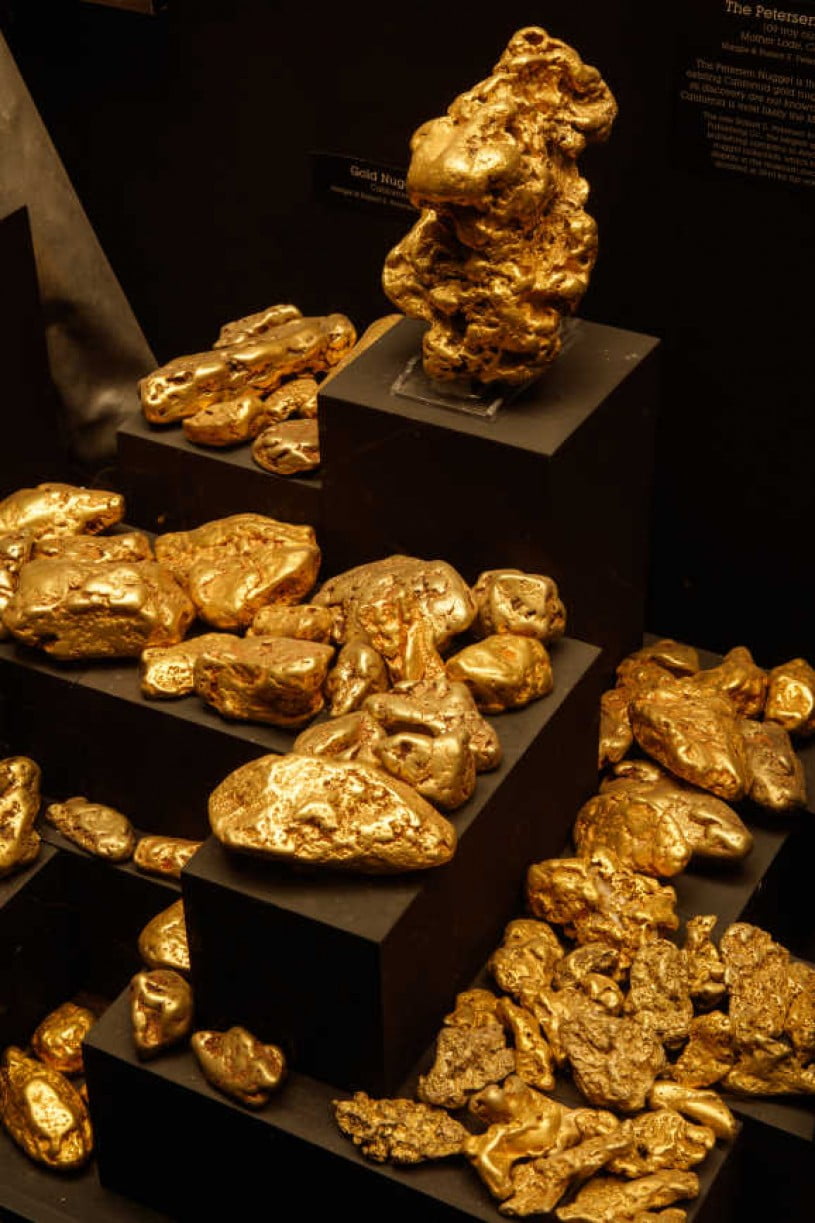The first significant gold discovery in the South was made in Dahlonega, Georgia in 1828. The Dahlonega Gold Rush followed, and the town became a hub for gold mining and prospecting in the region.

Dahlonega, Georgia played a significant role in the history of gold in the South. It was the site of the first major gold rush in the United States, preceding the California Gold Rush by more than a decade.
The discovery of gold in Dahlonega in 1828 attracted thousands of miners and prospectors to the area, and the town quickly became a hub for gold mining and trading in the region. Dahlonega’s gold rush lasted until the mid-1830s, and during that time, the town’s population exploded from a few hundred to over 10,000 people.

Today, Dahlonega is home to the Consolidated Gold Mine, which offers tours of the underground gold mine and a chance for visitors to pan for gold themselves. The town also hosts an annual Gold Rush Days festival, which celebrates Dahlonega’s gold mining history with live music, craft vendors, and a parade.
Dahlonega is also home to the University of North Georgia, which was originally founded as the North Georgia Agricultural College in 1873 to provide education for farmers in the region. The university’s campus includes the Price Memorial Hall, which was built in 1877 and served as the town’s U.S. Mint during the gold rush era.
Gold was also discovered in North Carolina in the early 1800s, with the famous Reed Gold Mine producing the first significant amount of gold in the US in 1803.
Gold mining in North Carolina played a significant role in the state’s economic development from the late 1700s to the mid-1800s. The state is home to one of the earliest gold rushes in the United States, which began in 1799 when a young boy discovered a 17-pound gold nugget in Cabarrus County. This discovery sparked a gold rush that would attract thousands of miners to the area over the next few decades.
During the height of the gold rush in the 1820s and 1830s, North Carolina was the leading gold-producing state in the country. Gold mining operations were scattered throughout the state, with the most significant concentrations of mines located in the central and western regions. Some of the most famous mines in the state included the Reed Gold Mine in Cabarrus County, the Randolph Mine in Montgomery County, and the Gold Hill Mine in Rowan County.
Most of the mining in North Carolina was done by placer mining, a technique that involves using water to separate gold from dirt and rock. Miners would use pans, sluice boxes, and rockers to extract gold from streams and riverbeds. As the easy-to-find gold became scarce, miners began using hydraulic mining techniques to extract gold from underground veins. This involved using high-pressure water jets to blast away the rock and extract the gold.
Despite its early success, gold mining in North Carolina began to decline in the mid-1800s as the gold rush shifted to other parts of the country, such as California. By the end of the 19th century, most of the state’s gold mines had been abandoned.
Today, visitors can learn about North Carolina’s gold rush history at several historic sites and museums throughout the state. The Reed Gold Mine, now a National Historic Landmark, offers underground tours and exhibits on the history of gold mining in the state. The North Carolina Gold Trail, a driving tour that stretches from Charlotte to Murphy, features several historic sites and scenic views associated with the state’s gold mining history.
Gold mining continued to grow in the South throughout the 1800s, with major gold rushes taking place in Georgia, North Carolina, and Alabama. The California Gold Rush in 1849 drew many prospectors away from the South, but gold mining remained an important industry in the region.
The discovery of gold in Alabama was an exciting time in the state’s history, and it sparked a gold rush that brought thousands of prospectors to the region. Although the Alabama gold rush was not as significant as the gold rushes in Georgia and California, it still played an important role in the economic development of the state.
The first gold discovery in Alabama was made in 1830 by Benjamin Parks in what is now known as Goldville. This discovery led to a rush of prospectors to the area, and by the early 1840s, several mining communities had sprung up in the region. The most significant of these was Arbacoochee, which became the largest and most prosperous gold mining community in Alabama.
One of the most significant events in the Alabama gold rush was the discovery of the Hog Mountain mine in Tallapoosa County in the late 1830s. This mine produced over $1 million worth of gold during its lifetime, and it was one of the largest and most productive mines in the region.
Despite the success of the Alabama gold rush, it was short-lived. By the late 1840s, most of the easily accessible gold had been extracted from the region, and the mines began to close. The California gold rush of 1849 also drew many prospectors away from Alabama, and the state’s gold mining industry never fully recovered.
Today, there are several sites in Alabama where visitors can learn about the state’s gold mining history. The Alabama Gold Camp in Lineville offers visitors the chance to pan for gold in Chulafinnee Creek, and the Hog Mountain Recreation Area in Tallapoosa County is home to the historic Hog Mountain mine site. The Alabama Gold and Mica Company in Ashland also offers tours of the site where the first gold discovery in Alabama was made.
During the Civil War, the Confederate government relied heavily on gold mines in the South to fund the war effort. Many mines were destroyed during the war, but gold mining resumed in the late 1800s and continued into the 20th century.
The gold rush in Alabama was largely driven by placer mining, which involved using pans, rockers, and sluices to extract gold from rivers and streams. The Chulafinnee Creek and the Tallapoosa River were the two main sources of gold in Alabama, and they attracted thousands of prospectors to the region.
Gold played a significant role in the history of the South, particularly during the Civil War. The discovery of gold in the southern states in the early 1800s sparked a gold rush that helped to fuel the region’s economic growth. Many of the mines in the South were located in areas that would later become key battlefields during the Civil War, making gold a valuable resource for both the Union and Confederate armies.
During the Civil War, gold was used as a means of financing the war effort. Both the Union and Confederate governments issued paper currency that was not backed by gold, leading to inflation and economic instability. In an effort to stabilize their economies, both sides began issuing gold-backed currency, and the search for gold became a top priority.
In the South, the Confederacy relied heavily on gold mines to finance its war effort. The largest gold mine in the Confederacy was located in Dahlonega, Georgia, which had been a major gold mining center since the 1820s. The Confederate government seized control of the Dahlonega mine and other gold mines throughout the South, using the gold to finance the war and pay soldiers.
The Union also relied on gold to finance its war effort. The U.S. government established the first federal gold reserve in Philadelphia in 1862, and the federal government began purchasing gold from private citizens to support the war effort.

The role of gold in the Civil War also led to the creation of the Charlotte Mint in North Carolina. The Charlotte Mint was established in 1835 to produce gold coins for the United States, but during the Civil War, it was used by the Confederacy to produce gold coins to finance the war effort. The Charlotte Mint was captured by Union forces in 1865, and it was permanently closed shortly thereafter.
While North Carolina, Georgia, and Alabama are often the focus of discussions about gold mining in the South, gold was also discovered in several other southern states.
In Virginia, gold was discovered in the early 1800s, and the state experienced a small gold rush in the 1830s. The largest gold mine in Virginia was the Whitehall Mine, which operated from the 1800s to the early 1900s.
In South Carolina, gold was discovered in the 1820s, and the state experienced a minor gold rush in the 1830s. The largest gold mine in South Carolina was the Haile Mine, which operated from the 1820s to the early 1900s.
In Tennessee, gold was discovered in the mid-1800s, and the state experienced a small gold rush in the 1830s. The largest gold mine in Tennessee was the Coker Creek Mine, which operated from the 1800s to the early 1900s.
Although these states did not produce as much gold as North Carolina, Georgia, and Alabama, their gold mining histories are still fascinating and offer a unique perspective on the history of gold in the South.

Today, gold mining is not as significant of an industry in the South as it once was, but the region still has several active gold mines. The largest gold-producing state in the South is currently Georgia, with the Haile Gold Mine in South Carolina and the Phoenix Gold Mine in Idaho both being major producers as well.
Gold is also an important investment in the South, with many investors turning to gold as a safe haven in times of economic uncertainty. Gold has historically been a hedge against inflation and currency devaluation, and many people believe that it is a good way to protect their wealth in turbulent times.
One popular way to invest in gold is through a Gold IRA, which is a self-directed individual retirement account that allows you to invest in physical gold and other precious metals. This type of investment is becoming increasingly popular in the South, as many people look for ways to protect their retirement savings from market volatility.
Another way to invest in gold is through gold mining stocks, which offer exposure to the gold industry without the need to own physical gold. There are many gold mining companies based in the South, including Barrick Gold, Newmont Corporation, and Alamos Gold.
Gold is also a popular choice for jewelry in the South, with many people opting for gold wedding bands and other gold jewelry. The South has a rich tradition of goldsmithing, and many jewelers in the region specialize in creating unique and intricate gold pieces.
Gold has played an important role in the South’s history, and it continues to be an important part of the region’s economy and culture today. While gold mining may not be as significant of an industry as it once was, many investors in the South are turning to gold as a safe haven in times of economic uncertainty.







